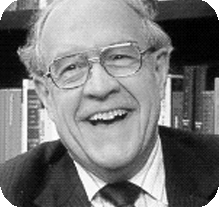ACM-IEEE CS Eckert-Mauchly Award
USA - 2004
citation
"For the definition of computer architecture and contributions to the concept of computer families and to the principles of instruction set design; for seminal contributions in instruction sequencing, including interrupt systems and execute instructions; and for contributions to the IBM 360 instruction set architecture."
ACM A. M. Turing Award
USA - 1999
READ FULL CITATION AND ESSAYcitation
For landmark contributions to computer architecture, operating systems, and software engineering.
Dr. Brooks received the A.B. in Physics from Duke University in 1953, and completed his Ph.D. in Computer Science from Harvard University in 1956, under Howard Aiken.
Dr. Brooks joined the IBM Corporation in 1956. He was an architect of the Stretch and Harvest computers, and there coined the term "computer architecture." With Dura Sweeney, he invented a Stretch interrupt system that introduced most of the features of today's interrupt systems. Later, as manager for the development of IBM's System/360 family of computers and Operating System/360 software, and he led the team that first achieved strict compatibility, upward and downward, in a computer family. His early concern for word processing led to his selection of the 8-bit byte, the decision to make the byte the addressable unit, and the inclusion of the full character set. All of these concepts are now universal practice. The 1997 book with G.A. Blaauw, Computer Architecture: Concepts and Evolution, documents and exemplifies the power of their 1960's innovation of thinking about computer design as separable domains: architecture, implementation, and realization.
Similarly, many of the technical innovations found in OS/360 - such as the approach to I/O handling and the method of transition between supervisor and user modes - are foundations of today's operating systems. Even more influential, though, is the distillation of the successes and failures of the development of OS/360 that Dr. Brooks captured in his 1975 book The Mythical Man-Month: Essays on Software Engineering. Today ' twenty-five years, two editions, and 300,000 copies later - this book remains a defining work in the field of software engineering.
In 1965, Dr. Brooks left IBM to found the Computer Science Department at the University of North Carolina at Chapel Hill. There, his research on real-time three-dimensional computer graphics has propelled that field forward, driven by the goal of creating tools to enable scientists and engineers to tackle problems formerly beyond their reach. He and his students built the first molecular graphics system on which a new protein structure was solved. They also first proved that haptic displays augmenting visual displays can significantly improve a scientist's understanding of data.
ACM Fellows
USA - 1994
citation
For outstanding innovations in computer architecture, including pipelining, instruction look-ahead, and cache memory.
ACM AAAI Allen Newell Award
USA - 1994
citation
In recognition of the breadth of career contributions of Professor Brooks within Computer Science and Engineering (CSE); and his interdisciplinary contributions to visualization methods for Biochemistry. Within CSE, he pioneered early computer development, then for IBM managed the development of the hardware and software for System/360, a landmark for its time that still influences the computer field today. He led the development of innovations in computer graphics and the application of computer graphics to the visualization and manipulation of biochemically important molecules.
The ACM Allen Newell Award was established to recognize both career interdisciplinary contributions and career breadth of contributions to Computer Science. Both were characteristics of the career of the great computer scientist after whom the award is named.
It is fitting that the first ACM Allen Newell Award be made to another great computer scientist, Professor Fred Brooks of the University of North Carolina. His career has included major contributions to the hardware and software most used in the computer world for two decades: the System/360 hardware and software. Working for IBM, he was the manager for the development of this hardware and software. He also made important architectural contributions to the pioneering Harvest and Stretch computers.
In Computer Science, he led the invention and engineering many of the methods and tools of computer graphics. This work on computer graphics was done in the context of displaying and manipulating visual models of complex molecules of importance to Biochemistry. The visualization tools he helped to develop are now standard tools in Biochemistry.
He is the author of the extremely influential book, The Mythical Man Month: Essays in Software Engineering, and the equally influential essay "No Silver Bullet."
Professor Brooks is a winner of the National Medal of Technology, the IEEE John von Neumann Medal, and many other high honors in Computer Science and Engineering. He is a member of the National Academy of Engineering and the American Academy of Arts and Sciences. He has served the national with the distinction on the National Science Board and the Defense Science Board.
ACM Distinguished Service Award
USA - 1987
citation
For outstanding innovations in computer architecture, including pipelining, instruction look-ahead, and cache memory.

